Southeast Foster Road feels a long way from the heart of Portland’s transportation conversation at the moment. But that’s not going to last long.
Next year, right in the middle of Portland’s mayoral election, Foster is scheduled to be the site of the city’s most ambitious road diet yet, a conversion of passing lanes to bike and turn lanes that’s widely expected to create auto spillover onto other streets even as it dramatically improves the safety of driving or crossing Foster, which is currently one of the city’s 10 high-crash corridors.
The new bike lanes will be nothing more than paint, but six-foot-wide or buffered. And in a comment beneath Tuesday’s story exploring how to divvy up Portland’s bike-infrastructure budgets, BikePortland reader Gutterbunnybikes made an interesting case that those bike lanes will be more important than you think.
Why? Because unlike almost every other bike lane in Portland, they’re going to run right through commercial districts.
Here’s Gutterbunnybikes’ answer to the question of whether Portland should prioritize coverage (a big, far-flung network) or ridership (a high-quality, heavily used network).
I think honestly think you can have both. It’s just that the thinking has to change on what the system as whole is and should be doing. If we actually started connecting commercial districts instead of skirting them, you get both. But Downtown is the only commercial district the city wants to connect to the bicycle grid.
You will dramatically increase ridership numbers and geographic influence if you plan right. Instead of half-assed 20’s and 50s projects – why were these routes not taken 10 blocks west which would have put the bicycle access in the heart of the main east side commercial districts instead of 10 blocks away from where everyone wants to get to in them?
A route through the teens would have given riders direct access from the heart of Alberta through LLoyd, central eastside, Division/Clinton then on down to Bybee/ Sellwood. A route through the 40’s would have connected the heart of Fremont to Hollywood, to Hawthorne, to Division/Powell, and Woodstock.
And you wait because Foster does connect commercial districts – once implemented it will be a game changer for future planning. Foster (coupled with Clinton and Tilikum) is going to be huge, once completed it’s roughly 5 miles of near complete (other than Clinton being two blocks off Division) commercial access for bicycles from 90th to over the bridge to Downtown.
As long as no one is willing to adequately connect all the commercial districts, all the projects which aren’t central city will fall short. And at some point, without better access from outside of central city even those projects will fail in that no one will be able to get to them.
Advertisement
In a separate comment, Gutterbunnybikes replied to another reader who offered to bet $100 that Foster’s painted bike lanes will be “very low use,” perhaps similar to the ones along NE Broadway between 15th and 24th.
You’ll lose that bet.
Foster already sees a pretty good amount of bicycle traffic. I’d likely guess near the same numbers of some of the outer and mid east side greenways. Since most the street side parking (defacto bike lane) is usually vacant, the FOPO section really isn’t too bad to ride, and I’ve often done my own counts on the east of 82nd parts where bicycles on sidewalks usually outnumber or equal the number of pedestrian traffic (including people waiting at bus stops) through that stretch.
In my modest opinion, I suspect Foster is going to increase bike share overall more than the 50’s and 20’s greenway projects (combined even).
Whether Foster Road’s redesign leads to pitchforks, praise, or both, it seems likely to shape the next five years of road redesign decisions in Portland for good or bad. Whether or not biking actually improves much along the way is anybody’s guess, but at least we know what this Foster-area resident is putting money on.
Yes, this feature is back after a hiatus caused by a long string of busy weeks — and yes, we pay for good comments. We’ll be sending $5 and a little goodie bag to Gutterbunnybikes in thanks for this one. Watch your email!

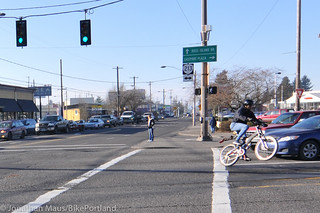
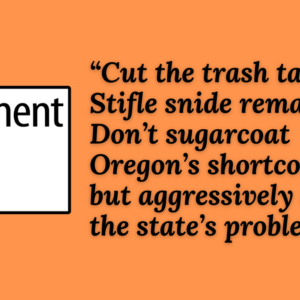
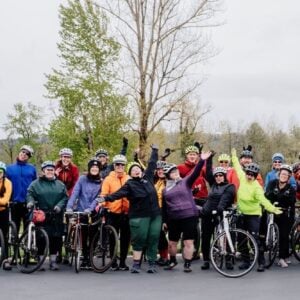
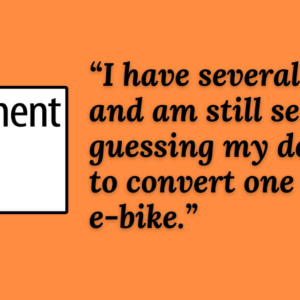
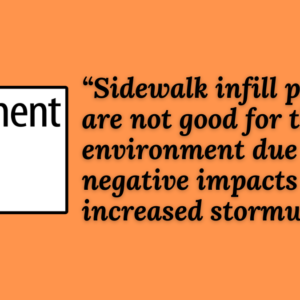
Thanks for reading.
BikePortland has served this community with independent community journalism since 2005. We rely on subscriptions from readers like you to survive. Your financial support is vital in keeping this valuable resource alive and well.
Please subscribe today to strengthen and expand our work.
All the more reason for PBOT to directly connect the Foster Rd bike lanes to the 52nd Ave bike lines, rather than skirt around the commercial district from 54th to 52nd.
seems like a great spot for a “people’s bike lane”.
While these bike lanes should have been protected or raised instead of in the door zone, I am looking forward to this project getting started. Foster is not currently a very welcoming place to bike or walk and the streetscape project aims to change that.
Foster isn’t getting a road diet, it’s getting reconfigured… they’re actually gaining a lane, and the width of the pavement isn’t changing…
and yes, there are already a lot of bikes on Foster… mostly on the wide sidewalks and not in the road…
These projects are commonly called “road diets”.
and crashes are commonly called accidents…
we should avoid the hysteria of the term “road diet” when a road isn’t losing lanes or width…
Fine, then let’s call it a car diet.
or a bike binge?
This would be sweet. This would provide a fast way to skip inner springwater and get out towards Powell Butte and Boring without wasting time and your life. All other routes are a compromise of either time or safety.
This WILL be sweet.
I’m really looking forward to the Foster streetscape project, and hope it proves successful enough that the City uses it as a precedent for other streets. I like the greenway network for what it is, but dislike that it often seems to be in place of bike lanes on commercial streets, rather than in addition to them.
Gutterbunnybikes’ observation about connecting commercial districts, and his listing of those districts, makes what should be the City’s north-south bike infra plans so blindingly obvious it hurts.
Do we know why the City hasn’t planned that way? I mean, apart from The Holy Sacrament of On-Street Parking? Is there some conscious reason, like, I dunno, a well-founded belief that the biking public wouldn’t go from one business district to another, but only from home to a single business district?
Or do they continue routing greenways and other infra around commercial destinations because of a deep-seated belief that everyone is really just a Sunday Parkways leisure/recreation rider who never thought of quaxing, or what?
The “interested but concerned” are the target audience for the neighborhood greenway system, and the City’s goal is to get more of them riding bikes. The greenway system has been enormously successful at growing ridership. While I agree we need more direct routes connecting commercial districts, I think greenways should remain a higher priority because they offer a safe and comfortable alternative to busy arterials.
Wait, what? I love greenways and will usually go out of my way a bit to use them. But “the greenway system has been enormously successful at growing ridership”? Evidence?
Hasn’t ridership grown a lot in the last 10 to 15 years, since the greenway system started getting built out? I get that there has been a plateau, but most of our greenways pre-date the ridership growth slow-down. I would argue that Clinton, Salmon, Ankeny, 42nd, 16th, Tillamook, Going, etc have contributed more to ridership than any number of narrow bike lanes.
no.
the greenway system is a recent thing and it’s underfunded and woefully incomplete (with most greenways not built to full greenway standards).
sadly, portland’s bike boulevards — the routes i marveled at when i first moved here 15 years ago — have fallen into disrepair with some routes fading into oblivion (e.g. just a few faded bike platters/discs).
as for bike mode share we have been stuck in a rut from 2007 through 2011 and of late have seen outright declines in bike mode share (2 years in a row).
The greenway standard is a recent thing. The concept of an alternative to mixing with high speed and high volume traffic on busier roads is not new – that is what bike boulevards were intended to do, and generally succeeded in doing.
Almost all routes with the bike platters were retrofitted with the sharrows as part of the ARRA funded projects.
Sweet wheelie, bro.
I’m glad someone else is noticing that trick too. XD
This commenter seems to be unaware that we do have a “40s Bikeway.” It runs along 41st/42nd Ave and connects multiple commercial districts from Hollywood south to Hawthorne and Division. It even continues up to NE along 38th.
Yes, paikiala pointed this out in response to the initial comment. I agree that it seems to be an oversight.
In GBB’s defense, I live within striking distance of the 40s bikeway myself and until last year I had basically never wrapped my head around the idea that all those squiggles were a coherent piece of infrastructure.
This!!!
I live near it and never think to use it. I just go on Chavez. Much, much quicker and easier.
I take 45th, it connects Ppmc with Clinton with no turns. The 40s is a terrible route. To get North of Hollywood, I take Hassalo to 37th to Sandy to 38 th. NMuch easier that that 1970s designed switchback.
Try it some time. It’s really useful.
I ride the 40’s route, it is pretty convenient and has some useful crossing aids. The new 50’s route is better, now. Cesar Chavez is not inviting at all.
Egads, more failed door-zone bike lanes. The plan is made worse by using a “buffer” to squeeze the bikes further into the door zone where there was actually adequate road width to keep most of the bike lane clear of it.
I’d rather have nothing than bike lanes in the door zone, since I won’t ride in that hazardous place, which puts me in the travel lane. Not surprisingly, this leads to a few angry motorists at times.
8 feet allows for a lot of riding outside of the door zone (and also not in the “travel lane”.
b_carfree has a point.
from 54th to 72nd it’s a 5 foot bike lane adjacent to parked vehicles. sure…it’s possible to ride in the buffer but this is illegal (according to pbot and multco staffers) and in my experience virtually no one in portland does this.
The plan should be amended to stripe buffers on both sides. 3.5 ft buffer on the door-zone side, 1.5 ft buffer on the moving-vehicle side. Yes, this leaves only 1 ft. Would go to show that the bike lane is really too narrow and in the wrong place….
Why not?. I routinely ride on the white line dividing unbuffered bike lane from traffic lane, and when there are buffers, often ride there.
perception of safety/comfort and perception of illegality — why we need better infrastructure and legal reform.
Not to mention I don’t know of a lot of car doors that are 5 feet wide.
people in portland tend to ride in the middle or right side of a bike lane so they would be fully within the door zone on this facility.
5 ÷ 2 = 2.5.
And yet we don’t hear about a ton of dooringings in Portland.
how does one to that conclusion for all of riders in Portland?
PBOT staff doesn’t realize that riding in the buffer or traffic lane is legal when the bike lane is one door wide? The city has some bikes they can use to do their job, right?
Agreed, why not build the lane curbside, instead of the fundamentally flawed, conflict-inducing current standard placement?
Because then you have a greater conflict with turning vehicles at intersections?
The reason they were not proposed to be behind the parked cars is because there isn’t enough room to do it with preferred dimensions. We’re literally 2-4 feet short of being able to do protected bike lanes unless we’re removing on-street parking, which the advisory committee wasn’t interested in doing.
There is going to be a design phase of the project coming up where the specifics are worked out before they get striped on the ground. Depending on the degree of public involvement the design may be something that can be revisited slightly. If PBOT is willing to consider 10 ft travel lanes next to 7 ft parking lanes, a protected bike lane may be possible in the current road width.
As an aside, regular plain bike lanes made out of paint are not fatally flawed. On the right street they can be just as comfortable and safe as a protected bike lane. (That said, Foster may not be the right street).
As an aside, regular plain bike lanes made out of paint are not fatally flawed. On the right street they can be just as comfortable and safe as a protected bike lane.
Heretic.
in the neighborhood accidentally named after the most famous pedestrian of the 18th century, there should be more pedestrian things to do. http://18thcand19thc.blogspot.com/2014/08/foster-powell-celebrated-pedestrian.html
Lol I typed that one out and it sat in moderation for awhile.
Yeah, I’m (and was) aware of the the mis-mash of the 40s “path”. I use to be a cab driver and know this cities roads very well, and honestly I don’t think I can navigate it without a map or route sheet for more than a few blocks. It’s terrible. It’s not nearly as coherent as the say the 50s path and the crossings of the arterials are horrid. One of these days I expect to see a giant hunk of cheese in the street for my reward for finding the end of that one.
But that wasn’t really the focus of my comment. I was stating that I don’t think that you need to make the choice between increasing ridership and geographic exposure to infrastructure. If you plan it right by making routes that actually take people somewhere they want to go you get both – especially the further out you get.
What is missing from this conversation isn’t “where” people bike, or “how” they’re riding, or even their skill/comfort level. The thing people need to ask is “why”. and the answer is people ride bikes in a city to get places – be it work, school, or for shopping and entertainment.
For example living in South Tabor I’ve got access to many commercial districts that aren’t Downtown. In fact there is little to no reason for me to go Downtown because of this access to other districts. Most parts Portland that are east of 39th (Chavez – it’ll always be 39th to me) fall into this same situation. Out here by connecting commercial districts in a sane manner will give you both greater access and and greater ridership numbers because of the access – throughout the system. And the Foster project will do this pretty well. Though as noted by a few others – it’s a huge oversight not to extend it another 10 blocks to the Springwater Trail.
And I don’t really think the central city for the work commute holds much water either. Downtown only accounts for roughly 25% of the cities employment. If the infrastructure is being developed to increase commuter traffic where are the paths on N/NE Columbia and Killingsworth? , Sandy? 82nd? Industrial NW? Perhaps even better access on Swan Island?
And at what point does increases in development downtown stall out ridership numbers? Are we possibly there now? Is the fact the city has been so focused on Downtown a factor in the fairly stagnate numbers the last couple years? Developing infrastructure downtown will only get you so far without developing the rest of the city.
There’s certainly a downtown bias when it comes to infrastructure. Even transit projects are downtown-centric. If the idea is a hub-and-spoke type setup it can actually be pretty efficient if there’s enough crossover between the different spokes away from the central city. Promoting bike trips as an alternative to short car trips may not show up statistically for the city’s plan to grow bicycle commuting but there is an impact none the less. For instance, I live in a somewhat isolated neighborhood near Burlingame. When I go to get groceries, I have in the past driven a half mile to the store only to circle the parking lot looking for a spot. I stuck a milk crate on my bike and was able to eliminate a rush hour car trip on Barbur and get a little exercise at the same time. Is success in ridership numbers measured solely by commuters or should elimination of short trips be considered as well?
“Though as noted by a few others – it’s a huge oversight not to extend it another 10 blocks to the Springwater Trail.”
There is already a bike lane from 205 to the Springwater on Foster.
Unless the projects that get the most cyclists per dollar spent happen to be the best at increasing coverage per dollar spent the coverage/ridership issue is still there.
“And at what point does increases in development downtown stall out ridership numbers? Are we possibly there now? Is the fact the city has been so focused on Downtown a factor in the fairly stagnate numbers the last couple years? Developing infrastructure downtown will only get you so far without developing the rest of the city.”
The city has done anything but focus on downtown. There exactly zero complete bidirectional bike routes through downtown in either the north-south direction or the east-west direction.
Diagonal roads that break with the grid are pretty valuable, not just for bikes but for all modes. Getting from a to b is a lot quicker when you can cut across an otherwise uninterrupted grid.. thanks Pythagoras..
NE Sandy has similar value to the north.
I totally agree and that is another factor on why Foster is so important.
I know it’s a huge sticky ugly quagmire, but the bicycle community should really be pushing for Sandy Blvd. over nearly every other (Barber perhaps the only road on par) bicycle project in the city – and I think Foster is the first step to redeveloping Sandy.
Two things that Sandy and barbur have in common is that they can be used as vehicular alternates to the 84 and the 5, respectively. I drive Sandy in a company vehicle to avoid the 84, and commonly drive barbur when my destination is beyond downtown. Foster doesn’t serve as an interstate alternate and is therefore an easier political sell. Probably helps that it’s under pbot instead of odot, as is Sandy(correct me if I’m wrong!). The same cannot be said of barbur.
The idea of interstates is supposedly high-speed grade separated movement THROUGH areas; routes such as the ones I have mentioned are much more appropriate for lower speed traffic like bikes and peds.
Vehicular traffic on all three of those roads move much faster than what is safe. A well enforced 30mph max would go a long way towards making them a bit safer for all users. Speed is the number 1 factor in car crashes.
“the bicycle community should really be pushing for Sandy Blvd”
the comprehensive plan discussion on Sandy was practically spammed by bike-specific comments. it was glorious.
Agree! Sandy is a very important road to get bike lanes on. I ride Sandy from Burnside to Hollywood often, but after Hollywood it is too difficult to ride eastbound (uphill so you are going much slower than cars). Going westbound is not too bad in spots (downhill so you can keep up with cars).
I’m thrilled about the Foster streetscape plan. I live in Foster-Powell, and it’s a huge pain to get to any Foster businesses currently. You have to figure out which cross-street will bisect the triangle just so. I will love just being able to ride straight down the road itself.
I live in the area as well and look forward to the plan that local community helped develop. I’m also hopeful businesses and further development will follow. The neighborhood has promise, but it needs a lot of work still.
I am fearful of the drunks leaving the bars on Foster, with only paint between them and me. Well, it’s better than nothing. I guess. We’ll see.
And this is different from any other bike lane or bar area in Portland how?
how is that different than any street at any time in any city?
This project is why I have been so aggressive in getting public endorsements for the 60’s (crosses at 67th) and 80th Greenways. They will feed directly into Foster from the north and south. Combined with Center, Raymond and Ellis…..assuming all of these feeder greenways are built properly…i.e. with proper DIVERSION….then the core of inner SE will have a great network for pretty cheap.
Yes, one of the big selling points for bike facilities on Foster from the city was that there really are no other bike facilities in the area around Foster (going in ANY of the directions).
as congestion worsens (reducing driving lanes),
that will make inner portland even more unafordable for the kind of min wagers who ride bikes
have fun moving to rockwood
us versus them
I live in Fo-Po, as many of us do. We won’t have to move anywhere, but I may enjoy cashing out in a few years!